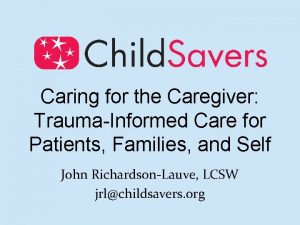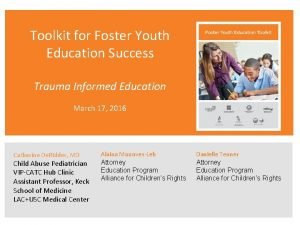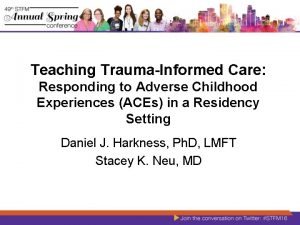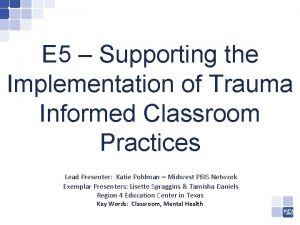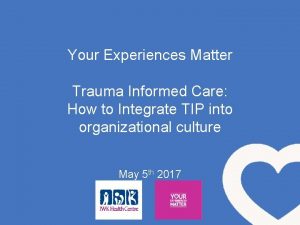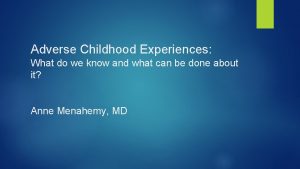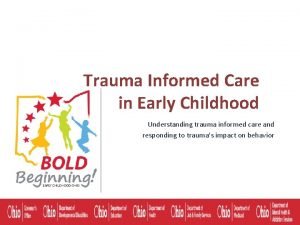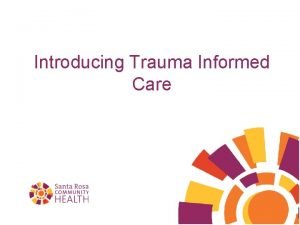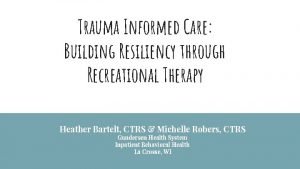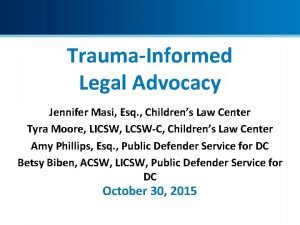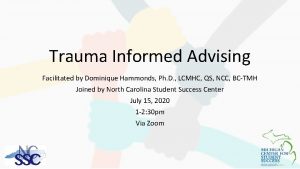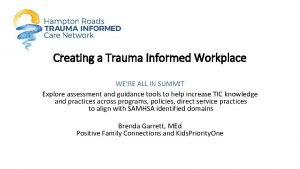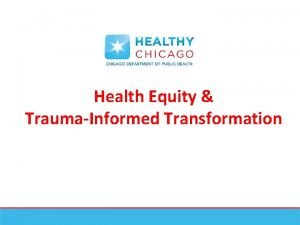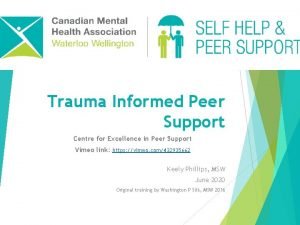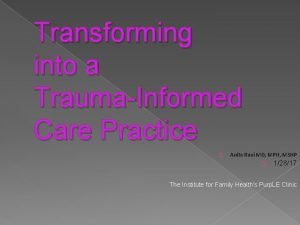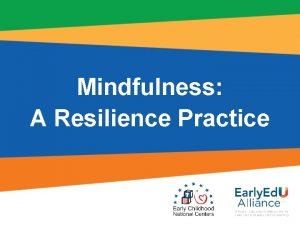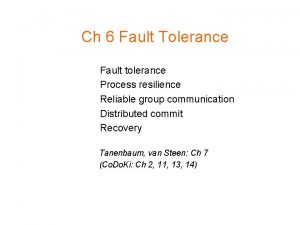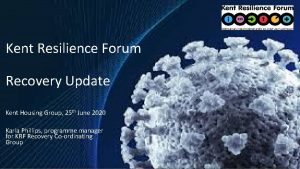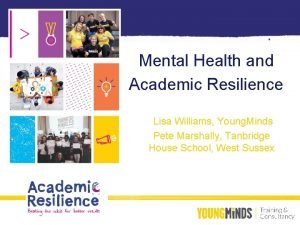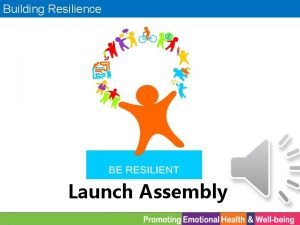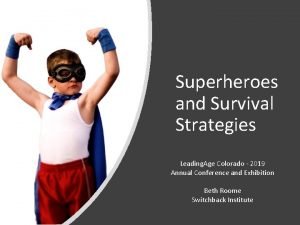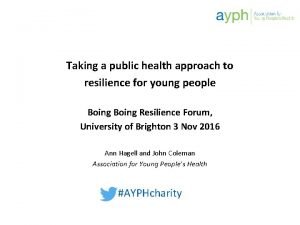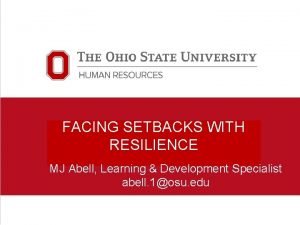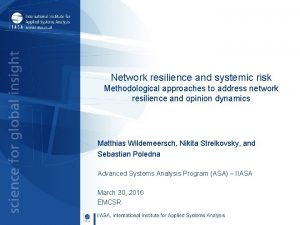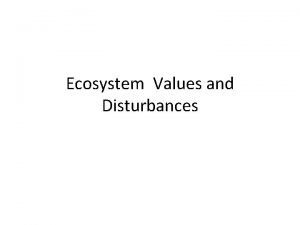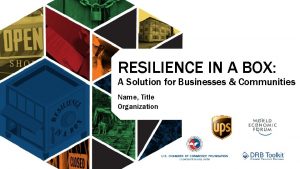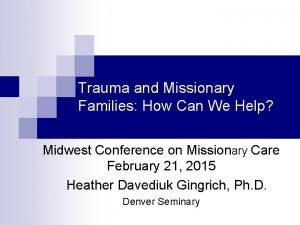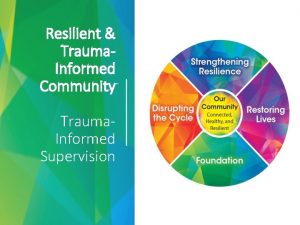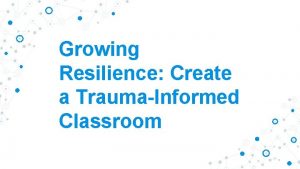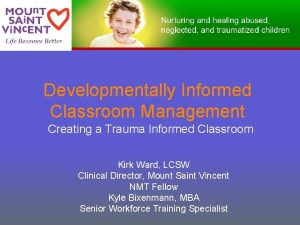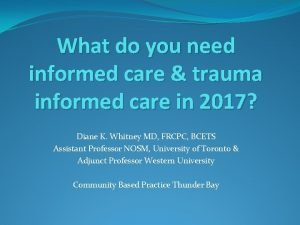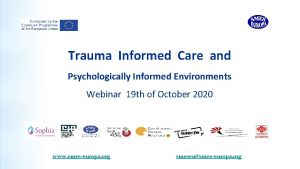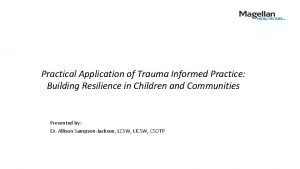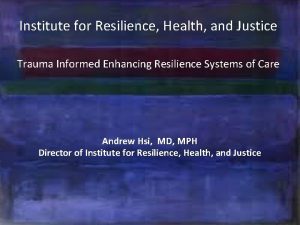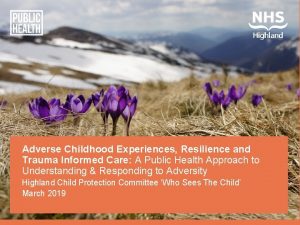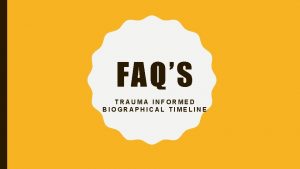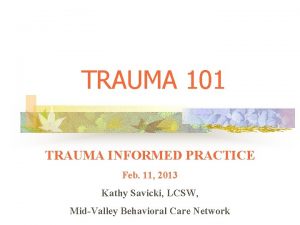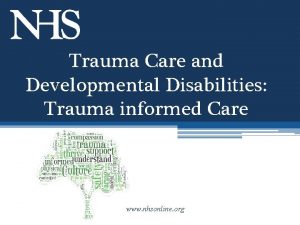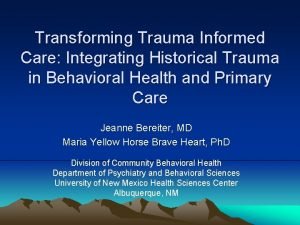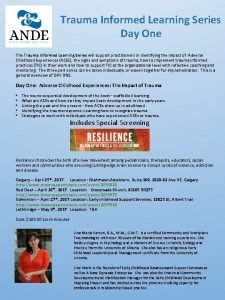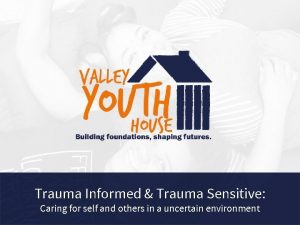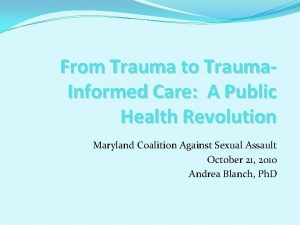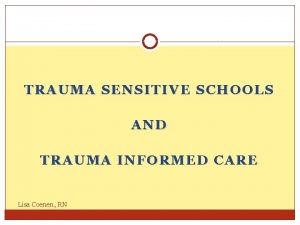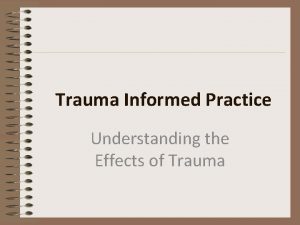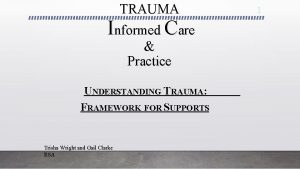Growing Resilience Create a Trauma Informed Classroom Create




































- Slides: 36

Growing Resilience: Create a Trauma. Informed Classroom


Create a Trauma-Informed Classroom Day 1 Day 2 Day 3 ◎ Trauma ◎ Behaviour ◎ Active Memories ◎ The Brain ◎ The Circle of Courage ◎ Present Moment ◎ Impact of Trauma on the Brain ◎ Domains of Self. Regulation ◎ Reflection and Journaling ◎ Neuroplasticity ◎ Triggers ◎ Story Telling ◎ Sensory ◎ Co- and Self-Regulation ◎ Healing through the Arts ◎ Resource Intensification

Jam Board Self-Awareness: How are you doing right now?

“ Teachers may not deal with trauma directly, but they are part of the healing process. They give their students order and predictability. After the chaos and confusion of their lives, nothing is more comforting than routines Pipher, 2002

Someone on My Mind

Breakout Room Who is on your mind?

What do we worry about for our students in the fall?

Chat Box What is our worry for our students in the fall?

“ Trauma can serve as a filter, or lens, through which a person views the world. Think of sunglasses: You put them on and everything is shaded differently. Trauma can have that type of effect on how a person perceives their world. ~Crisis Prevention Institute (2017)

Jam Board What do you think a Trauma-Informed Classroom is?

“ Trauma-informed care is a strength-based framework that is grounded in an understanding of and responsiveness to the impact of trauma, that emphasizes physical, psychological and emotional safety for both the provider and survivors, and that creates opportunities for survivors to rebuild a sense of control and empowerment. ~Popper, Bassuk, and Olivet (2010)


Prefrontal Cortex: complex learning and thoughtful decision-making. The Brain Amygdala: Limbic System Fight/flight/freeze to prepare for emergency events. Programmed to keep you safe at all costs. Hippocampus: Limbic System - regulates motivation, emotion, learning and memory.


Sequential neurodevelopment • The brain is undeveloped at birth. • The brain organizes from the “bottom” up — brainstem to cortex and from the inside out. • Organization and functional capacity of neural systems are sequential. • Experiences do not have equal “valence” throughout development. 2007 -2015 Bruce D. Perry

Video Dr. Dan Siegel: Neural Integration

The Brain and Trauma ◎ A brain that has experienced some sort of traumatic event reacts differently than a non-event brain. ◎ Researchers such as Dr. Perry believe that the more threat a brain perceives or experiences, it reacts to situations in a less mindful or intelligent way.

White Board What types of trauma are the lived experiences within your communities?

Types of Trauma Children mostly experience

Three types of Adverse Childhood Experiences (ACES) MEHRIT Centre

Video Intergenerational Trauma

Intergenerational and Historical Trauma ◎ Intergenerational trauma results when disturbing experiences have not been addressed and their emotional and behavioural legacy is passed down from parents to their children. Parents who experienced persistent trauma in childhood may struggle with their own ability to express empathy, compassion and self-regulation. Unresolved trauma may make it difficult for parents to build trusting relationships and healthy attachments. This trauma is then transmitted to future generations. ◎ Historical trauma goes beyond a single family to a community caused by historical, systematic abuse and injustice. In additional to family-specific intergenerational trauma, historical trauma may also result in shame and loss of culture and identity. The legacy of historical trauma can result in “repression, dissociation, denial, alcoholism, depression, doubt, helplessness, and devaluation of self and culture”.

Chat or Micophone How has intergenerational and historical trauma impacted the student on your mind?

Video Dr. Nadine Burke: Impact of Trauma on the Brain

The biology of abuse

The Biology of abuse

Three types of Adverse Childhood Experiences (ACES) MEHRIT Centre

“ Adverse childhood experiences are the single greatest unaddressed public health threat facing our nation today. ~Dr. Robert Block


Oppositional Defiant Disorder Anxiety 67% of people have at least ONE ACE 14 x Suicide Attempts Phobias 2 x Liver Disease 1/8 of the population have more than 4 ACEs 4 or more ACEs has long term health impacts 4. 5 x Depression ACES Forms of Trauma ADHD 3 x Lung Disease PTSD 7. 5 Point decrements in IQ 9. 8 Point decrements in reading achievement People with 6+ ACEs can die 20 years earlier than those who have none.

Changing the brain ◎ The brain is always changing. ◎ Plasticity is not uniform across all brain areas. ◎ It takes less time, intensity and repetition to organize the developing neural systems than to re-organize the developed neural systems. 2007 -2015 Dr. Bruce Perry

Implications and hope

Dr. Daniel Amen SPECT (SINGLE PHOTON EMISSION COMPUTED TOMOGRAPHY) https: //www. slideshare. net/robertinseattle/dr-daniel-amen-independent-retired-football-players-summit

Our brain is like a garden Source: https: //www. mamiewhitington. com/poetry//your-brain-is-a-garden

Homework Consider the child on your mind… – How might their relationship with school be impacted by trauma? – What insight do you have regarding your beliefs about this child?
 Acessexual
Acessexual Trauma-informed questions for clients
Trauma-informed questions for clients Trauma informed care for foster youth
Trauma informed care for foster youth Libby bergman
Libby bergman Trauma-informed care cheat sheet
Trauma-informed care cheat sheet Trauma infromed
Trauma infromed Trauma informed practice
Trauma informed practice 4 r's trauma informed care
4 r's trauma informed care 4 r's trauma informed care
4 r's trauma informed care Sensory modulation
Sensory modulation Trauma informed icebreakers
Trauma informed icebreakers Trauma-informed care cheat sheet
Trauma-informed care cheat sheet Trauma informed legal advocacy
Trauma informed legal advocacy Lgbtq trauma informed care
Lgbtq trauma informed care Trauma informed advising
Trauma informed advising Trauma-informed workplace checklist
Trauma-informed workplace checklist Trauma informed practice
Trauma informed practice Kobtion
Kobtion Anita ravi md
Anita ravi md Resilience practice
Resilience practice Building resilience skipper
Building resilience skipper Sourima mal
Sourima mal Jika noel(create(q)) adalah 0 maka front(create(q)) adalah
Jika noel(create(q)) adalah 0 maka front(create(q)) adalah Process resilience in distributed system
Process resilience in distributed system Kent resilience forum
Kent resilience forum Young minds resilience
Young minds resilience Camp resilience
Camp resilience Assembly on resilience
Assembly on resilience Leading age colorado
Leading age colorado Boing boing resilience
Boing boing resilience Resilience
Resilience Resilience pyramid
Resilience pyramid Emotional resilience in nursing
Emotional resilience in nursing Network resilience a systematic approach
Network resilience a systematic approach Ecosystem hypothesis
Ecosystem hypothesis Business resilience 101 workbook
Business resilience 101 workbook What is psychological first aid
What is psychological first aid

